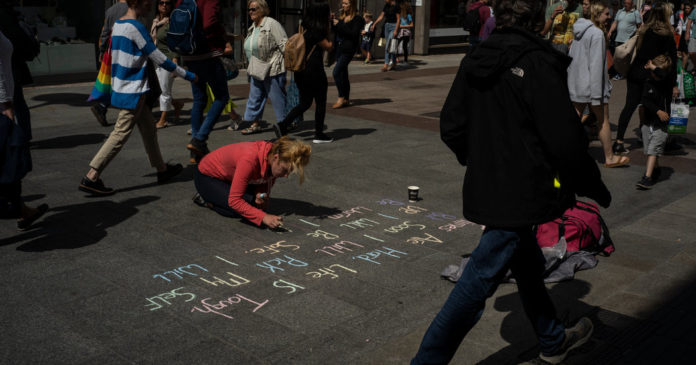(Want to get this briefing by email? Here’s the sign-up.)
Good morning.
We’re covering a staggering increase in Scotland’s drug-related deaths, a growing housing crisis in Ireland and a way to stop sea gulls from stealing your snacks.
Scotland rocked by addiction crisis
Last year, there were 1,187 drug-related deaths in Scotland — a record, and a staggering increase of 27 percent from the year before. Overdoses are more common in Scotland, by some measures, than even in the U.S.
There are almost 60,000 drug users in Scotland with routine, prolonged use of opioids or benzodiazepines. Many also suffer from physical and mental health issues, putting them at greater risk of dying from an overdose.
Why: The reasons for Scotland’s drug crisis are varied. Economic policies left areas deeply impoverished. Treatment services were neglected. Drugs became deadlier.
Quotable: “We’re seeing diseases that you would associate with old age in a lot of these middle-aged men with a long history of drug use,” said Dr. Carole Hunter, the lead pharmacist for Glasgow Addiction Services. “What your body tolerates at 18 it doesn’t tolerate at 38 or 48.”
Housing crisis grips Ireland, a decade after bubble
For generations, the Irish took for granted that affordable, plentiful housing was the bedrock of their economic security and government policy.
But the last several years have torn up those assumptions. Homeownership has dropped, while evictions and homelessness have climbed sharply; surging demand for rental units has led to a shortage; and soaring rents are fodder for daily conversation, political campaigns and street protests.
Details: In the last few years, Dublin has become one of the world’s 10 most expensive places for renters, ahead of cities like Tokyo, Sydney and Singapore.
History: Homeownership was long something of a national obsession. But by the 2000s, Ireland had a property bubble built on debt. When the financial crisis arrived in 2008, real estate prices plunged, people defaulted on loans, construction came to a halt and Irish banks, deeply indebted to foreign banks, flirted with insolvency.
The unexpected moves whipsawed financial markets. On Wall Street, the S&P 500 closed flat after an early dive of 2 percent. Investors’ worries that Australia’s central bank might be the next to act sent that country’s dollar to its lowest level against the U.S. dollar in a decade.
Related: Our Upshot columnist Neil Irwin writes that if a full-scale currency war breaks out, it risks upsetting a relatively stable world market order and the central role the U.S. has played within it.
Trump visits grieving cities
President Trump was not entirely welcome at the two American cities plunged into mourning by mass shootings last weekend.
Early Wednesday, he visited a hospital in Dayton, Ohio, to thank emergency and hospital workers, and he met with survivors of the shooting that left nine dead. But there were protests, with demonstrators waving signs that read “Dump Trump” and “Do Something!”
Later, the president traveled to El Paso, where 22 people were killed in one of the deadliest mass shootings in Texas history. The city has a tense relationship with Mr. Trump, who has called it violent and dangerous and used it as an argument for his border wall.
After a police officer killed an unarmed black teenager in Ferguson, Mo., in 2014, protests over race and policing rocked the U.S., and the small community’s law enforcement policies were forced into the spotlight.
There have been changes in Ferguson since then, with far fewer traffic tickets, fines and arrest warrants issued. But black drivers, like De’Shaun Bunch, above, are still stopped at much higher rates than white drivers.
Here’s what else is happening
ICE raids in U.S.: About 680 immigrants believed to be undocumented were arrested at their workplaces in Mississippi, in what might have been the largest worksite enforcement action ever carried out in a single state.
Hong Kong: A top Chinese official said the former British colony was experiencing its worst crisis since its return to China in 1997, as antigovernment protests continue with no end in sight.
Snapshot: Above, security personnel patrolling the Spanish Steps in Rome on Tuesday. Sitting on the iconic steps is now subject to a fine of 400 euros, or about $450, under new rules barring a variety of activities “not compatible with the historic and artistic decorum” of the city’s tourist draws.
Sea gulls: Have pesky birds ever stolen your food? A new study suggests that staring them down may fend them off. An experiment by the Royal Society in Britain found that herring gulls were far less likely to swoop down on potato chips if someone next to the chips was facing the birds.
Beyoncé: A portrait of the star, shot for Vogue last year by the rising photographer Tyler Mitchell, is on its way to the Smithsonian’s National Portrait Gallery.
Nicolas Cage: In The Times Magazine’s latest Talk column, the actor opens up about his stolen dinosaur skull, his literal quest for the Holy Grail and how cobras informed his acting.
What we’re reading: This article in Cosmopolitan. “Please do not try to convince me after this week that we’re not in a post-apocalyptic future far more dire than ‘Back to the Future II’ imagined,” writes our Magazine writer Taffy Brodesser-Akner. “I am consoled only by great stories like this one, by Andrea Stanley, about the A.D.L.’s best weapon against hate, a savant who is like a ‘Minority Report’ pre-cog for white supremacists and anti-Semites.”
Now, a break from the news
Smarter Living: “There’s a lot wrapped up in the word ‘no’ for women — beginning with the fact that women are expected to say yes (and feel guilty when they don’t),” writes our gender editor, Jessica Bennett. So, following the example of a professor at New York University and two colleagues, she’s starting a “No Club,” and inviting you to join. Members will help one another decide when to say no and how exactly to say it.
And for those shopping for a school computer, we have guidance on how to find one that isn’t junk for under $500.
And now for the Back Story on …
A floating tradition
About 60,000 rubber ducks will take a plunge into the Chicago River today in a race to raise money for Special Olympics Illinois.
Rubber duck races started in Canada in the 1990s and now are fund-raisers the world over. London claims the title for most ducks — 250,000 in the River Thames in 2008. (Last month, the start of the London race was delayed because a family of real ducks got in the way.)
Racing ducks are a little different from the bathtub variety: They are specially made with a weighted bottom.
The toy itself had its origins in the mid-1800s, about the time the American engineer Charles Goodyear figured out how to make rubber malleable. The first rubber ducks were meant as chew toys and didn’t float.
The Russian-American sculptor Peter Ganine gets credit for the design of the rubber ducks we know now, patenting his in 1949 and selling 50 million of them. Disney and Sesame Street helped.
Even the queen of England is said to have a rubber duck (complete with crown).
That’s it for this briefing. See you next time.
— Melina
Thank you
Alisha Haridasani Gupta helped compile today’s briefing. Mark Josephson and Eleanor Stanford wrote the break from the news. Victoria Shannon wrote today’s Back Story. You can reach the team at briefing@nytimes.com.
P.S.
• We’re listening to “The Daily.” Our latest episode is about the successor to Osama bin Laden.
• Here’s today’s Mini Crossword puzzle, and a clue: Painter of a melting clock (4 letters). You can find all our puzzles here.
• The New York Times’s paid subscriptions reached a new high, 4.7 million, in the second quarter of this year. Nearly 3.8 million are digital and include our news, crossword and cooking apps.
Source : Nytimes














